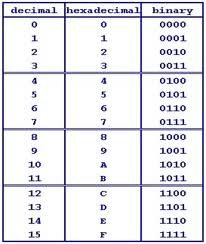Converting Binary to Hexadecimal

Every now and then it’s nice to take break from tutorials, and look at something a little geekier. We’ve all seen binary code, and most people know it’s made up of two characters, zero and one. Most people also understand that binary code can be converted into decimal by taking the binary number from the right-hand-side of the sequence and applying it to another sequence of numbers “two to the power ofâ€. For example an eight digit binary code could look like this – “10010001â€. This includes one “1â€, one “16â€, and one “128â€, making a grand total of 145. That’s fairly simple. It gets more complex when you add more numbers but the principal is the same.
Now – if you do a lot of HTML work, you will have seen codes that represent colors. These codes include letters, and are in hexadecimal. The letters are actually numbers but because the characters we commonly use are in base 10, i.e. the digits 0 through to 9, we have to use letters to represent the numbers 10,11,12,13,14 and 15. This is because hexadecimal is base 16, and has 16 digits including zero. We don’t use two characters in a hexadecimal number until we get to the number 16, which is actually “10â€. This represents one sixteen. The hexadecimal number “18†is actually sixteen plus 8, which is 24. The hex code “1F†represents 31 in decimal because we have one sixteen plus 15. Get the idea?

Okay, so we can mostly work out what a hex number in decimal is when we only have two characters. One digit represents how many “16â€s we have, and the other is simply counting from zero to fifteen. So the highest number we have is “FFâ€, which is fifteen times sixteen, plus fifteen. The answer is 255. Already you can see the benefits of hex, because in binary that number would require eight characters, and we’ve done it in two.
So how do we solve bigger numbers into decimal easier? The answer is to split each hex character into its binary equivalent. So the hex number 8FA4 becomes in binary 1000.1111.1011.0100. Here we can see each number that makes up the ultimate answer. Starting from the left we have a 4, a 16, a 32, a 128 etc… all the way up to the last character, which is a 32,768. Add all the numbers represented by ones together and we have 36772. So our hex code of 8FA4 is actually 36772 in decimal. Four characters to represent something that is sixteen characters in binary is very impressive indeed.
If you remember back your hex codes in HTML that represent colors, you’ll notice that you have hex codes of 6 characters. The first character represents 16’s, the second 16’s to the power 2, the third is sixteen to the power 3 and so on. If you work it out, the largest number you can have with six hex digits is 16,777,215. Nearly seventeen million colors represented by only six characters.
Advertisement
















By combining bits (binary digits) into groups (e.g., bytes), it can represent various data types like text, numbers, images, and instructions.
Thank You for your tutorial Melanie it was very helpful, also; Thank you Defiant for helping with some unclear examples and showing how to convert hexadecimal to decimal without taking it back to binary code.
here is an on-line web app that makes it easy to learn about binary and hexadecimal numbers.
http://justwebware.com/bitwise/bitwise.html
Thanks for posting Rob, great find.
Slow news day?
“Nearly eighteen million colors represented by only six characters.” should now be “Nearly seventeen million colors represented by only six characters.”
This is one of the worst articles I have ever read.
So many inaccuracies, typos, and grammar issues…wow.
1) “It’s gets more complex…”
2) “…split each hex character into it’s binary equivalent”.
“it’s”? Really?
3) “8FA4 is actually 36,788 in decimal”…ehhh…no, it’s 36,772 in decimal.
4) If you have a hexadecimal number that you want to convert to decimal, you don’t have to convert it to binary first.
8FA4 in decimal is 8*16^3 + 15*16^2 + 10*16 + 4 = 36,772.
Even if you chose to convert to binary first, your explanation is severely lacking and unclear.
5) “the third is sixteen’s to the power 3”.
“sixteen”, not “sixteen’s”.
6) “If you work it out, the largest number you can have with six hex digits is 17,895,696”. No… FFFFFF = 16,777,215.
Horrific.
“So the hex number 8FA4 becomes in binary 1000.1111.1011.0100.” … A is 1010.. not 1011.